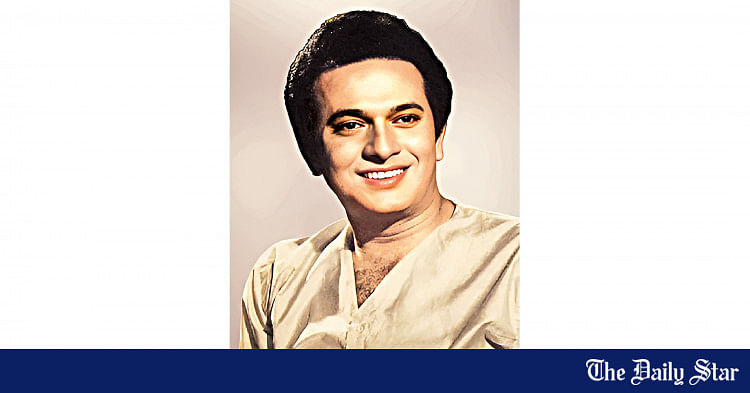Nayakraj Razzak: A new man in the 1960s
Nayakraj Razzak (January 23, 1942 - August 21, 2017)
In the often-treacherous world of showbiz, there is always "something else" beyond mere skill, charisma, and looks that contributes to stardom. A hero is unique, irreplaceable, and reigns until the time of another hero arrives. A hero representing a specific era in film often signals something new, marking the arrival of his time and distinguishing him from the hero of the previous generation. The identifiable traits in a star usually cannot be replaced by those of another, as in a Fordist-Taylorist model of enforced standardized methods. Therefore, there is an element of irreplaceability in a star.
Irving A. Thalberg, Hollywood's "boy wonder" producer, saw this in stars. He famously said that in movies, more than anything else, the actor is "the thing." If Thalberg is one of the founders of what André Bazin called the "genius of the system," there is another strand of filmmaking. François Truffaut learned from Jean Renoir that the actor portraying a character is more important than the character itself.
Representative film stars, particularly those who play leading roles, frequently embody larger-than-life or deeply relatable characters on screen, so these portrayals and the presence of the stars allow us to explore the historical contexts in which such heroes became possible.
Razzak, who earned the honorific title of Nayakraj, meaning "the king of heroes," is widely recognized as the most famous and successful movie star in the Bangladeshi film industry. By the mid-1960s, his presence loomed large on the silver screen of Bengali cinema in East Pakistan, and it never "got small." Over a career spanning more than half a century, in addition to immense cinematic success, Razzak achieved the status of a cultural icon. What kind of hero was Razzak, considering his arrival, rise, and elevation to prominence coincided with a time when the political and cultural life of Pakistan's eastern province was undergoing unprecedented changes? Razzak's significance is related to and needs to be understood in the context of the time when the political and cultural realities of East Pakistan were presenting new possibilities.
A scene from Behula
After a period of struggle and uncertainty upon arriving in East Pakistan as a refugee from West Bengal, Razzak's first major cinematic break came with Behula. Based on the Mangal-Kavya and directed by Zaheer Raihan, this movie is one of the most significant cinematic creations in East Bengal. Razzak's entry in the film was not marked by the typical dazzling, low-angle shot often reserved for heroes. His entrance was rather natural and spontaneous. As Lakhindor, the beloved youngest and only surviving son of the wealthy merchant Chand Saudagar, Razzak walks into the frame unwittingly and, without much care, enters the realm ruled by the snake-goddess Manasa Devi, carrying a peacock—an animal that the deity views as an arch-enemy.
Behula was an instant blockbuster. In this movie, Razzak as Lakhindor is cursed by the snake goddess Manasa due to her wrath against his father. From halfway through the film, Razzak had to portray a dead character whose body is taken to heaven by his wife, Behula. Yet the audience felt deep sympathy for this character and discovered the star they had longed for. Rafiuddin Babu, the writer of the only biography available on Razzak, has rightly said, "From the cursed Lakhindor, there occurred his radiant rise." It was a significant film not only for Razzak's career but also for revitalising Bengali cinema. The success of Behula, much like Rupban, released a year earlier, helped sustain Bengali cinema and played a crucial role in rekindling Bengali cultural nationalism. Coincidentally, both the famous Six-Point Demands and Behula appeared in the same year—1966.
Bengali film enthusiasts had been trying to establish a film industry in East Bengal since the early 1950s. From the mid-1950s to 1962, most of the films produced in East Bengal were Bengali. However, during the heyday of Ayub Khan's rule, many Bengali film producers turned to making Urdu films, as Bengali cinema faced hostility from the government, both in terms of opportunities and censorship. For instance, in 1963, there were sixteen films under production in East Pakistan, but only three were in Bengali.
At this juncture, Zaheer Raihan and Salahuddin turned the tide for Bengali cinema by deciding to make folk-fantasy genre films. It seems that while Bengali filmmakers were struggling, they figured out that films based on folklore and legends lent an element of originality and authenticity, making them distinct from others' stories. Hegel identified legends, ballads, and traditions as fugitive, shadowy elements, and poetic expressions belonging to a nation's half-awakened state. Perhaps these "dim and hazy forms" have a profound connection to the people's psyche, which explains Behula's success. Equally significant was the role played by Razzak. Filmmakers and movie lovers discovered in Razzak a hero they could capitalise on and relate to. Zaheer Raihan understood this, which is why he was adamant about casting Razzak, despite reservations from many.
Poster of Jiban Theke Neya
Razzak may not have been the most manly actor in the traditional sense, nor even the best in terms of acting skill. When he arrived in Dhaka, the film scene was not empty—there were already good actors who had a certain degree of acceptance in romantic, tragic, or social hero roles. Yet, at a time when Bengali cinema was struggling to carve out a niche in East Pakistan, Razzak brought a unique affective quality to the screen that resonated with the masses. All the established stars before him were involved in both Bengali and Urdu films. Razzak was the first star who concentrated solely on Bengali films.
Razzak's immense popularity among the masses and the high demand from filmmakers can be gauged by the fact that between Behula in 1966 and 1970, he was cast in nearly 45 leading roles, with almost all of them being commercially successful. By 1972, he had completed his 100th film—a testament to his popularity and inevitability in the industry.
It is true that Razzak was, on the surface, modelled after other heroes of the subcontinent, most notably Uttam Kumar. Directors likely cast him with the image of those heroes in mind, seeing a resemblance or shadow of them in Razzak. Even his fans and cinema-goers noticed similarities between Razzak and these established movie stars. However, despite the outer resemblance to other stars, the characters he portrayed—righteous youngest sons, unemployed youths, writers, and protesting students—brought originality and authenticity to his roles, shaped by the specific historical and sociological context of the time.
To understand what Razzak brought to the screen, we need to look at 1960s East Pakistan. The 1960s in East Pakistan were marked by stark contrasts, despite Ayub Khan's well-publicised narrative of development and progress. Signs of modernisation and the availability of modern amenities were evident. However, only a select few could bask in the affluence generated by the military-bureaucratic dictatorship—primarily upper-echelon government employees, a few businessmen, and successful professionals like doctors and university professors.
While the elite group relished the cosmopolitanism of the Ayub regime, on the other end were the grim and emaciated masses—workers, porters, peasants, and rickshaw pullers with bidis tucked behind their ears, street urchins staring into the glass windows of toy stores, and angry, impoverished students with little hope for jobs and a better future. In this situation, seeing a young man in his early twenties like Razzak—jolly, full of life, and pleasant—was definitely refreshing.
A star represents social reality and thus reflects the desires of the people. When we see Razzak in the films of the 1960s, it's impossible not to notice his fresh and jovial presence. We see him coming back from university, dancing and singing to "Neel Aakasher Niche Ami Rasta Cholechi Eka." He is going out with Kabori, Sujata, or Shabnam on romantic and amatory adventures in the Garden of Ramna, on a boat on the river, or in a popular couple's spot on the outskirts of Dhaka. Razzak exudes a sense of newness. He often arrives late to a rendezvous, playfully coaxing and cajoling his sweetheart for making her wait. The song of persuasion and flattery by a prospective lover, "Aynate Oi Mukh Dekhbe Jakhon," or the beautifully poetic and romantic song of courtship, "Tumi Je Amar Kobita," embody something new for the audience. These culturally and aesthetically significant songs encapsulate this new spirit and possibility.
What I want to convey about Razzak's acceptance becomes more tangible in Jibon Theke Newa, another Zaheer Raihan film that stands as the most significant cinematic creation in the history of Bangladeshi cinema. This powerful political film was set against the backdrop of the mass movements of 1969 and was released in 1971. Razzak, as part of an ensemble cast, plays one of the main characters—a student leader living under the oppressive rule of his autocratic sister, who governs the household with an iron fist, much like Ayub Khan ruled the country. The film was an allegory for the military dictatorship of Ayub.
Although Razzak's character is crucial to the movie, he has less screen time than some of the other key characters. Yet, the way his character is portrayed is both distinctive and indicative of something new. He first appears during the Prabhat Pherry on February 21st, singing the anthem of the language movement. Throughout the film, he is rarely seen inside the house. Instead, he is always outside—at the Shaheed Minar, at Curzon Hall, or leading protests with fellow students, workers, and peasants. When he returns home from the Prabhat Pherry, barefoot, he enters without tiptoeing. When his domineering sister scolds him for being out and threatens to end his education, he barely pays attention. Unlike others in the family, Razzak's character is distinctively defiant, shrugging off the house's prescribed strict rules and norms.
His character in Jibon Theke Newa embodies the spirit that poet Shamsur Rahman eloquently wrote about in his poem, where the grandfather, astonished, wonders, "Who is it that frequents this old house?" He is like the character Rahman cast from the resounding streets of 1969—the teenagers, full of life, who ignored the cautionary tales of their elders, rolled up their shirt sleeves, and swiftly joined the unadulterated exultation of the endless processions. It is worth noting that in 1971, much like his movie character, Razzak took to the streets to protest against the military dictators of Pakistan.
If we are to use the hackneyed but relevant phrase that social change is first reflected in the arts, then it can be said that Razzak, as a star, was contemporaneous with—or even a progenitor of—the youths who would soon participate in mass movements and the liberation war. If workers, students, writers, and intellectuals were agents of the changing sixties, so too was Razzak through the more popular medium of cinema. We cannot downplay the political and cultural significance of the popular cultural expressions embodied in the characters Razzak portrayed in his movies during the sixties.
To be continued...............








